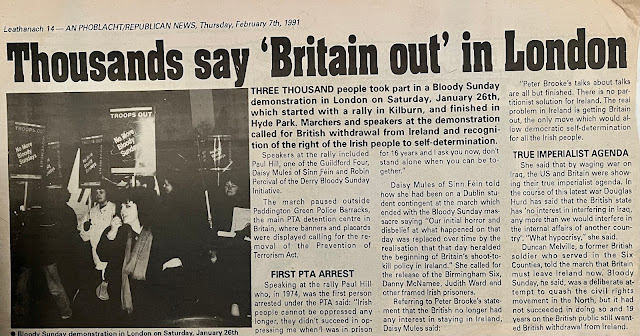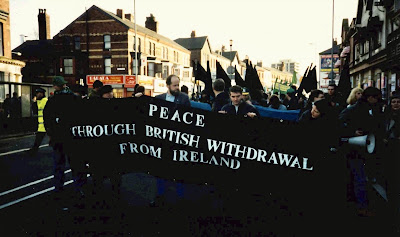A while ago I posted chronologies of
police and parties from 1996 and
1997. Here's some more from 1994 and 1995, all from England unless otherwise stated.
1994
January
( N.Ireland): A member of the Royal Ulster Constabulary is acquitted of the murder of 19 year-old Kevin McGovern in 1991, and will now return to police duty. McGovern was shot in the back on his way to a disco in Cookstown. The policeman claimed he thought the youth was armed (he wasn't). A few weeks earlier (on December 23) two British soldiers were found not guilty of the murder of Fergal Carraher, an unarmed man who was shot dead at an army checkpoint in Cullhana in 1990.
March
(N.Ireland): 16 people are arrested and many injured as RUC police with riot gear and dogs attack young people leaving a dance in Omagh. As the dance finished, police sealed off surrounding streets. People are beaten about the head with three foot long batons and plastic bullets fired.
April
Richard O’Brien, a 37 year old father of seven is killed by police from Walworth police station in south London. He had been to a dance at an Irish centre after a christening; outside he got into an argument with cops who held him down on the ground for 5 minutes after handcuffing him. In 1995 an inquest jury found that he had been unlawfully killed.
November
100 police raid Riverside club in Newcastle, making 33 arrests
December
Police raid on Final Frontier, techno night at Club UK, Wandsworth, South London
1995
May
Police with riot shields raid a techno free party at the ArtLab, Preston and impound the sound system, decks, records and other equipment. 21 arrests [Mixmag July 1995]
(Scotland): Drug squad cops harrass people at Ingnition II, a commercial rave in Aberdeen. 75 people were searched (some of them up to four times in a half hour period), and some arrested.
3000 people attend an all-weekend free party organised by United Systems at a disused air force base near Woodbridge, Suffolk featuring Virus, Vox Populi, Jiba, Oops and Chiba City sound systems. Police shut down the party on Monday afternoon, arresting four people and confiscating equipment (all returned within two weeks).
Police close down free party put on by Transient and Babel sound systems near Bangor (Wales).
Heavy police presence at Phenomenon One at the Hacienda, Manchester. Although there was no trouble, the police complained that there were too many people smoking grass and drinking after 2 am, and the management cancelled future jungle nights.
June
Police raid Home in Manchester, and call for it to be closed down permanently. It doesn’t reopen until December.
July
The weekend of July 7th 1995 saw the first major police operation using the ‘anti-rave’ sections of the Criminal Justice Act. Cops across the country coordinated their efforts and successfully managed to prevent the planned 7/7 “mother” of all free festivals. To stop people dancing in a field, police:
- raided the houses of people believed to be involved in organising the party and charged eight people with “conspiracy to cause a public nuisance”;
- took over the party info phonelines and questioned callers;
- used helicopters and set up roadblocks to stop people getting to planned festival sites at Corby (Northants), Sleaford (Lincs.), and Smeatharpe (Devon) where ten people were arrested.
- seized the sound system belonging to Black Moon (a free party collective based at Buxton, Derbyshire), charging three people under Section 63 of the CJA, the first time it has been used.
- used Section 60 of the CJA to set up five mile exclusion zones around festival sites.
Thousands of people took to the roads in search of the festival, and despite the efforts of the police several smaller parties did happen, including at Grafham (where over 1000 people partied) and at Steart Beach near Hinckley Point in Dorset where 150 vehicles managed to gather.
Bottles and bricks thrown at police by people being turned away from a warehouse near Huddersfield, Yorkshire where a party was to be held. 3 people are arrested after shop and police car windows are smashed.
70 police raid Progress house night in Derby. Everybody in the club (punters, staff and security) searched and made to leave, and the club was closed down
On July 23rd 1995 Reclaim the Streets closed down one of London’s busiest roads and held a big free party. Publicity for ‘Rave against the machine’ had been circulating for weeks with only the venue a secret. While police wondered where the action would be hundreds of people poured out of Angel tube station and blocked Islington high street, transforming it quickly into a car free zone. Banners calling for an end to the “tyranny of the motor car” and “support the railworkers” (on strike) were hung across the road, and sound systems, including one fitted onto an armoured car, sprang into action. Chill out spaces were created with bits of carpet on the road and a few comfy armchairs, as well as a giant sandpit for children. A couple of thousand people partied from noon to about seven o’clock while the police watched on unamused. After the music finished and most people had gone home, riot cops took out their frustration on those left behind, baton charging them down to Kings Cross, and making 38 arrests
(Scotland): “The friendly ‘boys on blue’ or rather ‘psycho cops in combat gear’ launched a massive, over-the-top drugs raid on the Kathouse club in Lockerbie. About 50 of them burst in, handcuffed everyone and carted them off to Lockerbie and Dumfries police station. Everyone was interrogated, finger prints were taken and they had to mark on a plan of the Kathouse where they had been sitting and they were all strip searched. The police treated everyone like shit. The Kathouse holds about 150 people max. It’s in a small town and the club itself is not very big. .. The music ranged from house to hardcore, the atmosphere was electric, there was never any violence... 6 people out of 77 were charged with possession of drugs” [M8, October 1995.]
August
(Canada): In Shuswap territory, a sacred sundance and burial site was been occupied by Native Americans. At the end of August 1995, heavily armed Royal Canadian Mounted Police cut off all communications to the Shuswap camp, and surround the area. One Canadian cop refered to the sundancers as “dancing prairie niggers”. [Earth First Action Update, September 1995]
(Argentina): Police arrest 130 gay men and transvestites after storming the gay pub Gas Oil in Buenos Aires on suspicion of ‘corruption’. In Mar del Plata, 60 lesbians and gay men were stripped searched and arrested in the Petroleo disco [Pink Paper, 1 September 1995]
September
(Iran): “A bride has been sentenced to 85 lashes in Mashhad, Iran, for dancing with men at her wedding. The court sentenced 127 wedding guests to floggings or fines and jailed one man.” [Guardian, 5 September 1995]
(Ireland): Tribal Gathering II, due to take place in Cavan on September 30th, is cancelled after the local police object. A local cop says that they did not have the resources to stop “the undesirable elements that shows of this nature attract”. Cavan County Council had initially approved the event, but after the intervention of the Garda they moved the goalposts and said that the organisers (Universe and The Mean Fiddler) would need planning permission, impossible in the time remaining.
Over 114 arrests (mainly for drugs) at Dreamscape, a commercial rave at Brafield Aeordorome, Northampton.
35 people arrested in police raid on party at Clyro near Hay-on-Wye on the Welsh border.
October
150 police raid Club UK in south London. Operation Blade involved dogs, horses, and the Territorial Support Group. 800 clubbers were turned out on to the streets, and many searched. 10 people were arrested
(Wales): Police raid 37 pubs and clubs in mid-Wales, making 50 arrests after seizing various drugs
11 people are nicked in a a drugs raid on Happy Jax in south-east London.
On Saturday October 21st 1995, 600 people block Deansgate, one of Manchester’s busiest shopping streets for a Reclaim the Streets protest. People dance and party until 5:00 pm, when the police threaten to arrest the Desert Storm Sound System (veterans of Hyde Park and Bosnia). The crowd move to Albert Square (outside the Town Hall) where they carry on till the morning.
November
(Scotland): 30 police raid Slam at the Arches in Glasgow.
150 police wait outside Dance Paradise event in Great Yarmouth searching people and making 86 arrests ; the rave was spread over three venues and the police stopped and searched people as they moved between them. The police invited BBC and ITV crews to film the operation [Mixmag, January 1996]
Manager of the Mineshaft gay club in Manchester convicted under the Disorderly Houses Act 1751 for supposedly allowing men to have sex with men in a back-room at the club (raided by police in April 1994 with 13 arrests).
The owner of Peckham gay bar Attitude fined under an 1832 Act for “allowing disorderly behaviour”. Undercover cops in leather visited the club earlier this year, as did two Southwark Council Licensing officers. The latter attended an underwear party and stripped down in the spirit of things before reporting that they had seen men having oral sex and four men dancing, when the bar had no dancing licence [Gay Gazette 8 November 1995]
The House of Lords refuses to repeal the Sunday Observance Act of 1780 which forbids pubs and clubs from charging for dances on the Sabbath. While horse racing and shopping have been allowed, the Lords ruled Sunday dances too sensitive and needing more public consultation. The Metropolitan Police have written to pubs warning them that they could be fined for breaking these rules. Since New Years Eve falls on a Sunday some events (such as a Sign of the Times party at the ICA) have already been cancelled. The law also requires special licences to extend music, dancing and drinking hours on a Sunday [Time Out, November 1995, Gay Gazette, 8 Nov. 1995]
December
Police raid the Dolphin gay pub in Wakefield at 2:30 am on Boxing Day and arrest 15 people because “Licensing laws were being broken”
Seven people become the first to be found guilty under the “rave” sections of the Criminal Justice Act, after being arrested at a party on the site of an anti-roads protest in Whitstable, Kent
(Australia) 20,000 people from all over the world turn up for the Bondi beach party in Sydney on Christmas Day. Police threaten to ban next year’s party, or at least make it alcohol-free after rioting at the end. On New Year’s Eve, there is more trouble: 12 people were arrested and rocks and bottles were thrown at cops.


















































